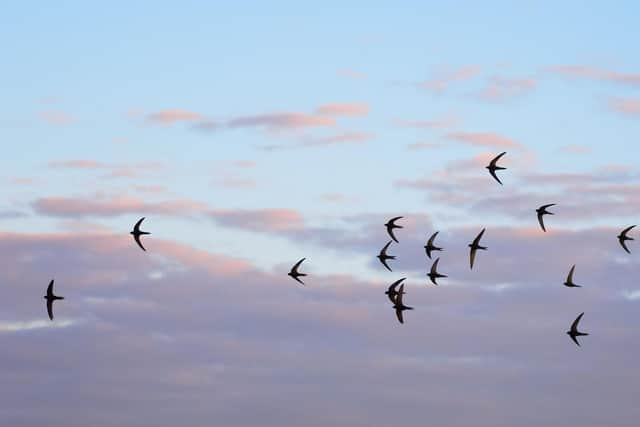Conservation groups mark Swift Awareness Week by raising awareness of the migratory bird's declining numbers and the Yorkshire Dales National Park Authority puts out a plea for more sightings
Summer plans made by Helmsley Swifts group had to be put on hold before the migrating birds had even started their return journey from the Congo region of Africa. But they have been able to continue work putting up nest boxes and with the help of a grant from Helmsley Town Council and the North York Moors National Park, 51 have been placed around the town.
Swifts have been returning to sites around the country since May with the birds who bred and built nests the previous year returning first.
Advertisement
Hide AdAdvertisement
Hide AdAt the end of May younger birds arrive and begin looking for nest sites before finally, in June and July the youngest birds arrive, looking for a colony to join. From the end of June through to July swift numbers are at their maximum and it is the perfect time for swift watching.


Author and artist, Jonathan Pomroy, who runs Helmsley Swifts with Ian Kibble and Paula Sidebottom, described swifts as the “ultimate natural symbol of summer”.
“Although our events for Swift Awareness Week have been cancelled, the swifts are well and truly here and we can enjoy watching them,” he said.
Over the years swift numbers have been declining and they have suffered in recent years as newer buildings no longer give access to the roof space where they nest.
Advertisement
Hide AdAdvertisement
Hide AdMr Pomroy, who has also written a book on swifts, said in Helmsley many enter under the pantiles just above the gutter and as these gaps are filled swifts are then homeless and have difficult task of finding a new nest site.
“Nest boxes are one answer to this problem,” he said.
“Playing swift calls speeds up the process of occupation and Helmsley Swifts has provided call systems at various locations to help with this.
“Once the first few nest boxes are occupied swifts learn to recognise similar nest boxes.”
Mr Pomroy said the way a bird nests is a simple way to tell the difference between swifts, swallows and house martins.
Advertisement
Hide AdAdvertisement
Hide AdHe explained, swifts nest within a roof space and do not use mud. House martins nest under eaves or on the outside of a building and swallows nest within a structure such as a shed or stable.
Anyone can put up a nest box to help swifts and Mr Pomroy said the group would be happy to help with advice. He said they are also looking forward to next season when they will be holding their events once again.
To find out more by emailing [email protected]
A second appeal has also been made for records of swift nest sites or screaming parties in the Yorkshire Dales National Park.
The National Park Authority originally put out an appeal last month and since May recorded sightings at Castle Bolton, Grassington, Kilnsey, Orton, and Sedbergh have been submitted to either the National Park Authority or its project partner, the Sedbergh Swift Community Group.
Advertisement
Hide AdAdvertisement
Hide AdA video of swifts has been captured in the town of Hawes , which can been seen above, as well as an audio recording of their distinctive ‘screaming’ calls. Both have also been published on the Swift Conservation Project webpage.
Wildlife Conservation Officer at the Yorkshire Dales National Park Authority, Ian Court, said: “We are really pleased with the response so far to our appeal for records on swifts; it is great that people are looking out for these fantastic birds.
“The records of screaming parties have been really useful. We hope that these can be followed up by a growing number of local swift enthusiasts who might go that step further and submit records of nesting sites. This sort of information would help us and partner organisations conserve swifts.
He said Swift Awareness Week is the ideal time to take part in the survey and help us find out about the nesting locations in the National Park.
Advertisement
Hide AdAdvertisement
Hide AdTanya Hoare, from the Sedbergh Swift Community Group, said: “Now is the peak time for watching out for swifts, as the adults are feeding chicks and darting more frequently into their nests. If you've seen screaming parties, spend some time in that area to see if you can locate the nest sites.
“It is so heartening to hear from the many people who have looked up and noticed swifts, so please make the most of the next few weeks to report your sightings. If we are to give these thrilling birds a future, this is the very best way to help us look after them.”
To find out more go to the yorkshiredales.org.uk